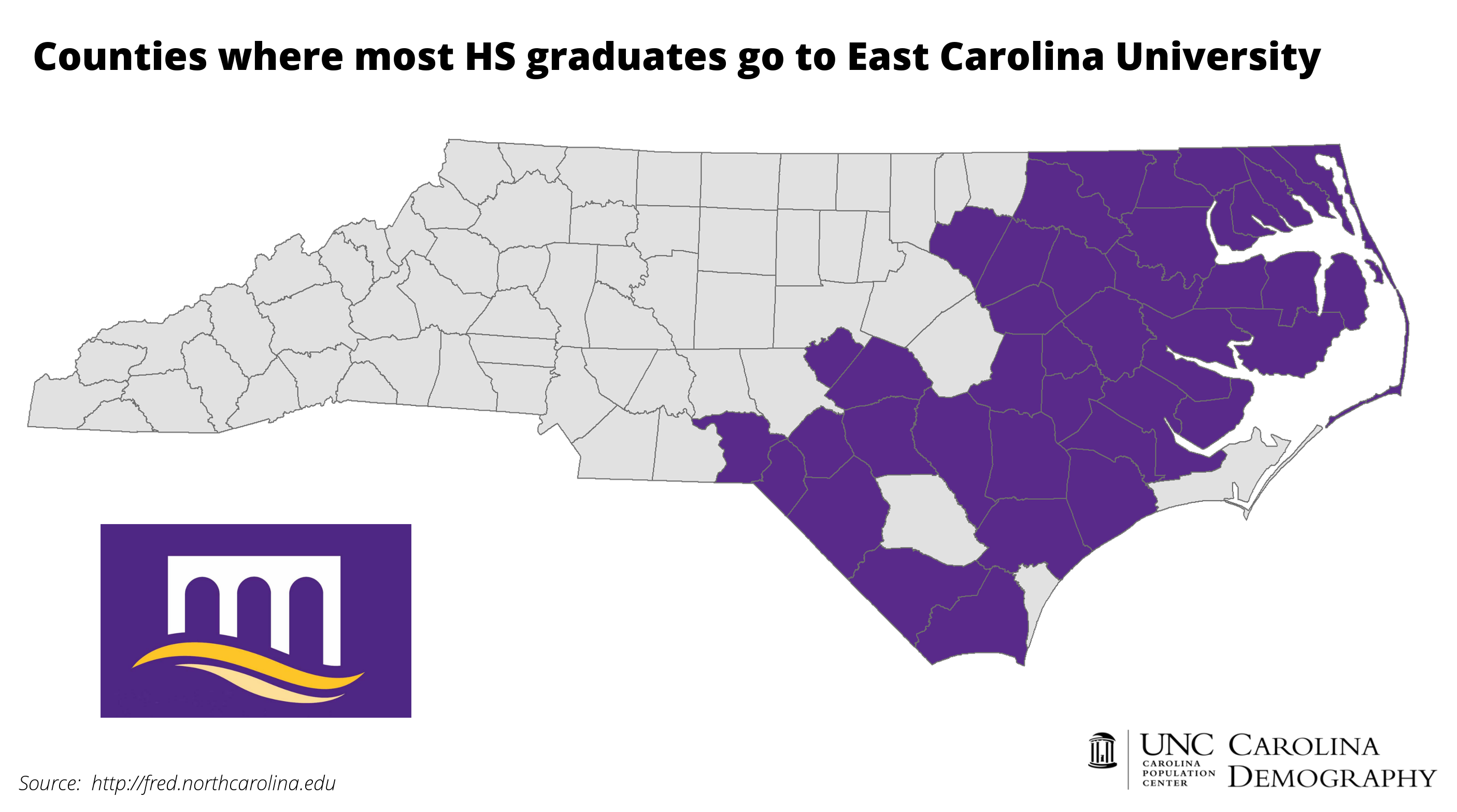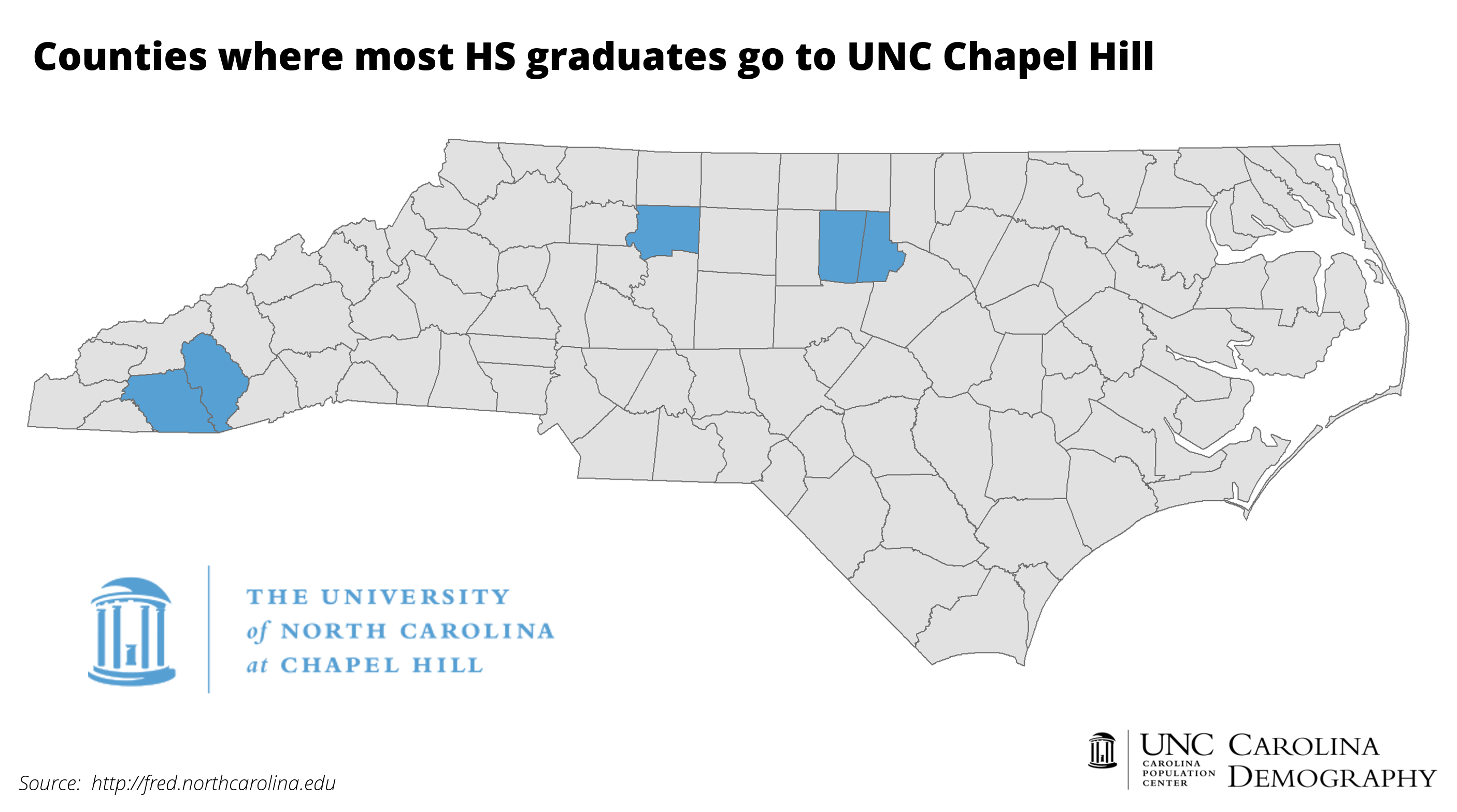Update: Examine attendance at all UNC system schools here.
With May 1 fast approaching, college-bound high school seniors are facing decisions about where they will be this fall. Within North Carolina, they are choosing between many universities. Focusing on the five largest universities in the University of North Carolina school system—Appalachian State, East Carolina, NC State, UNC Chapel Hill, and UNC Charlotte—here’s a look at the school each county’s high school graduates is most likely to attend.
I used the “Home Base of Students” data and focused solely on first-year college students who were new high school graduates to best capture flows from counties into the universities. To smooth out year-to-year variations in the data, I used 5 years of student enrollment records covering 2009 to 2013. The school that received the largest average number of graduates was designated the school that high school graduates from that county were most likely to attend.
Between 2009 and 2013, an average of 3,879 North Carolina high school graduates went to NC State each year, the largest number in the state. The second most common destination was East Carolina with an average of 3,417 students. UNC Chapel Hill (3,206), UNC Charlotte (2,704), and Appalachian State (2,509) rounded out the top 5 destinations for first-year students.
As the state’s largest population centers, Wake and Mecklenburg counties dominate the flows of students into state universities. Wake is the biggest first-year sending county at Appalachian State, East Carolina, NC State, and UNC Charlotte; Mecklenburg is the second biggest sending county at these four schools. At UNC Charlotte, Mecklenburg is the most common county and Wake is the second most common.
Note: In the maps that follow, some counties appear colored on more than one map. In these cases, there were multiple universities that had the same average amount of first-year college students from that county.
Appalachian State is the college destination of choice for many high school graduates in western North Carolina. Among college-bound high school graduates attending one of the five universities examined here, more than half from Watauga (73%), Avery (59%), and Ashe (55%) head to ASU each fall. At the other extreme, no high school graduate from Gates or Tyrrell counties has attended ASU in the past 5 years.

In contrast, East North Carolina is the main destination for college-bound high school graduates from the eastern portion of the state. And, the dominance is even more profound. Among students heading to one of these five universities, more than half of students in 17 counties choose ECU. Similar to patterns seen at Appalachian State, ECU rarely pulls students from North Carolina’s western counties.
While NC State dominates as the destination of choice in many of the Piedmont counties, it pulls from both the mountains and the coast, as well, attracting students from all 100 counties. Although it is large, NC State does not pull a majority of college-bound seniors from most counties; only in Caswell did half of the seniors headed to one these five universities go to NCSU.

Like NC State, UNC Chapel Hill pulls high school seniors from all 100 counties. Because it has a smaller enrollment and its students are from a broader array of counties, there are few counties where UNC Chapel Hill is the leading destination of college-bound seniors. It is the dominant destination among high school graduates in Orange, Durham, Forsyth, and Jackson counties. In Macon, students are equally likely to attend ASU or UNC Chapel Hill.

On average, more than half of UNC Charlotte’s first-year students from North Carolina come from six counties: Mecklenburg, Wake, Union, Guilford, Cabarrus, and Forsyth. And, UNC Charlotte exhibits the most marked patterns of regionalization of the five universities examined here. Since 2009, UNC Charlotte received no first-time freshmen from five counties (Bertie, Gates, Pamlico, Hyde, and Tyrrell) and received an average of less than 1 per year from 8 other counties.
Looking at the maps reveals distinct regional patterns for Appalachian State, East Carolina, and UNC Charlotte. Because UNC Chapel Hill has the largest proportion of out-of-state students, will a state-by-state analysis reveal different patterns of dominance? I’ll take a look at this next week.
Your support is critical to our mission of measuring, understanding, and predicting population change and its impact. Donate to Carolina Demography today.